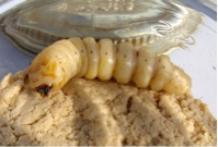ANOPLORISK
Detection of Asian and Citrus Longhorn Beetles using Bioacoustic Signal Processing
ANOPLORISK is a European transnational research initiated via the EUPHRESCO (European Phytosanitary Research Coordination) ERA-Net (network of national funders of plant health research in Europe). The project is led by the Food and Environment Research Agency (FERA) in the UK and involves the following countries: Austria, Belgium, Denmark, Germany, Italy, The Netherlands, and the UK (Defra and the Forestry Commission). The research providers from the UK are FERA and University of York (Defra funded) and Forest Research. The total project cost is 664,482 euro (approx. £558,164) over two years (2011-2012).
The project is investigating methods for the detection of two quarantine species of beetle – the Chinese Longhorn (CLB – Anoplophora chinensis) and Asian Longhorn (ALB – A. glabripennis). The larvae of these species live inside trees such as Acers and bonsais, and even inside wooden packing materials. Globalisation of trade has made it much more likely that they could be imported. They are considered to be of major potential economic importance and one recent report has stated that the potential cost to the UK for loss of timber production, forests, amenity trees, etc for ALB alone could exceed £1.3B if it gains a foothold.
Outbreaks in the USA have cost more than $600M and the destruction of 60,000 trees so far. So, efficient detection methods are required to aid in the inspection of trees and packaging material at the point of entry. This is the main task for Anoplorisk.
The work carried out at York follows on from two successful previous projects investigating the use of vibration sensing to detect the larvae feeding inside wood and aims to provide reliable and practical low cost solutions. The vibration sensors are piezoelectric sounders and the software is capable of detecting feeding sounds at SNR as low as 2dB using a fractal dimension detection method.
It is also possible to distinguish between different species using a novel pattern recognition approach using relational trees to describe waveform shape. This has been tested with 2 and 3 species discrimination with over 95% recognition accuracy.
The project at York finished at the end of 2012 and produced the following deliverables:
- a low cost 8 and 16 channel reliable solution for plant health inspectors and researchers to detect larvae in imported Bonsai and other trees;
- extensive testing and design of the acoustic sensors;
- two types of simulated larva for sensor testing;
- a library of the feeding sounds of 12 species of wood-boring beetle larvae including Anoplophora glabripennis and A. chinensis
- designs for wireless networked sensors.

